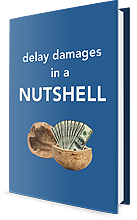The Three-Step Process to Prove Construction Inefficiency

Let’s talk about how to evaluate allegations of inefficiencies on a construction project.
First and foremost, the evaluation of any request for additional compensation is a three-step approach. These three steps are:
- Establish Entitlement
- Measure the Impact
- Quantify the Damages
Establish Entitlement
The entitlement step of an inefficiency or lost productivity analysis starts with the contract. We must ask the question:
Does the contract support the recovery of additional costs that result from the inefficiency?
Before performing any evaluation of the project data, the contractor must demonstrate that the contract affords the contractor the ability to request additional compensation for the alleged change that occurred.
Then, after establishing that the contract provides the contractor with the ability to seek additional compensation for the alleged change, the contractor must then establish that there was, in fact, a direct cause-and-effect relationship between the alleged change and the alleged inefficiency.
What we find in a lot of instances is that many claims, especially those with inefficiency or lost productivity components, fail to establish this cause-and-effect relationship between the alleged change and how the alleged change affected or impacted the efficiency of the contractor’s operation.
One thing to remember here is that, while inefficiencies can cause additional costs; the inverse is not true. Just because a contractor’s operation experienced additional costs, that does not mean that the increased costs were caused by the operation being less efficient. Or more to the point, there’s no guarantee that that reduction in productivity was caused by an owner-directed change.
That’s why establishing a direct link between the owner-directed change and the affected work operation is so essential. Without this direct link the contractor fails to demonstrate that its reduced productivity and increased costs were the owner’s responsibility and not the result of its own mistakes, issues, or problems.
We use the contemporaneous documents (the documents created and used during the project) to establish the link between the change and affected work. We do this by reviewing the change order, identifying the changed work, and then determine whether the changed work (or other work affected by the change) is the same work for which the contractor is seeking additional compensation. Note that any analysis should address language in the executed change order limiting the contractor’s ability to seek additional compensation related to the changed work covered in the change order.
Similarly, if an alleged change was not acknowledged by the owner by a change order issued during the project, the contractor still has the same burden of establishing the cause-and-effect link between the alleged change and the affected operation.
To move past the entitlement phase, the contractor must answer “yes” to both of these questions. Yes, the contract affords the contractor with the ability to recover additional compensation for the alleged change. And, yes, the alleged change is a direct cause of the reduced efficiency of the contractor’s operation.
Only after the answer to both of these questions is “yes” can the analysis move on to the second phase, which is measuring the impact of the alleged change.
Measure the Impact
How can the contractor’s operation be impacted? There are many ways that a contractor’s operation can be impacted: delayed, inefficient, addition of work, etc. that can result in additional, unanticipated costs. However, for this discussion we are going to focus on measuring whether or not a contractor’s operation experienced a reduction in productivity.
We begin by reviewing the contractor’s performance of that work. Did the performance of the contractor’s operation take longer than anticipated or planned? Did the contractor expend more resources than expected to complete a particular amount of work?
The best way to measure a reduction in productivity is to compare two time periods of the same operation on the same project. A comparison of the productivity of these two periods (unimpacted and impacted) will result in the calculation of an inefficiency factor, which is the productivity of the unimpacted period minus the productivity in the impacted period divided by the productivity in unimpacted period (U-I/U). This inefficiency factor provides a percent of lost productivity in the impacted period as compared to the unimpacted period.
Only after:
- We’ve established that the contract affords the contractor the ability to recover additional costs for the change,
- The contractor has established a cause-and-effect relationship between the change and his/her inefficient operation, and
- We’ve measured the contractor’s reduction in productivity or inefficiency of the contractor’s operation.
Only then, do we move on to the last step.
Quantify the Damages
In this last step, we quantify the increased cost that resulted from that alleged change and inefficient operation. The first step involves applying the inefficiency factor to the labor and equipment hours expended during the impacted operation, and potentially even other subcontractor hours expended on the inefficient operation during the impacted period. This calculation identifies the additional labor and equipment hours that are attributable to the change or alleged change.
Then, these additional labor and equipment hours can be priced to calculate the resulting damages.
Don’t Waste Your Time
Remember, we want to evaluate alleged inefficiencies only in the order identified above. If you can’t get past the entitlement step, you don’t move on to the impact step. If the contract does not provide a way to compensate a contractor for the additional costs for a change, then there’s no reason to even identify whether the contractor’s operation was affected or impacted. Further, there’s no reason to calculate the resulting damages.
Remember that this process, this entitlement-impact-cost process, is a time-tested and recommended method for demonstrating and evaluating a contractor’s entitlement to the recovery of additional costs.
Mark Nagata is a Director/Shareholder of TRAUNER and is an expert in the areas of critical path method scheduling, delay and inefficiency analysis, and construction claim preparation and evaluation. He loves to get questions at mark.nagata@traunerconsulting.com.
If you liked this article, be sure to sign up on the left side of our website to receive our Ideas & Insights in your email. Be sure to check your email after signing up!

